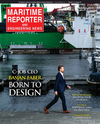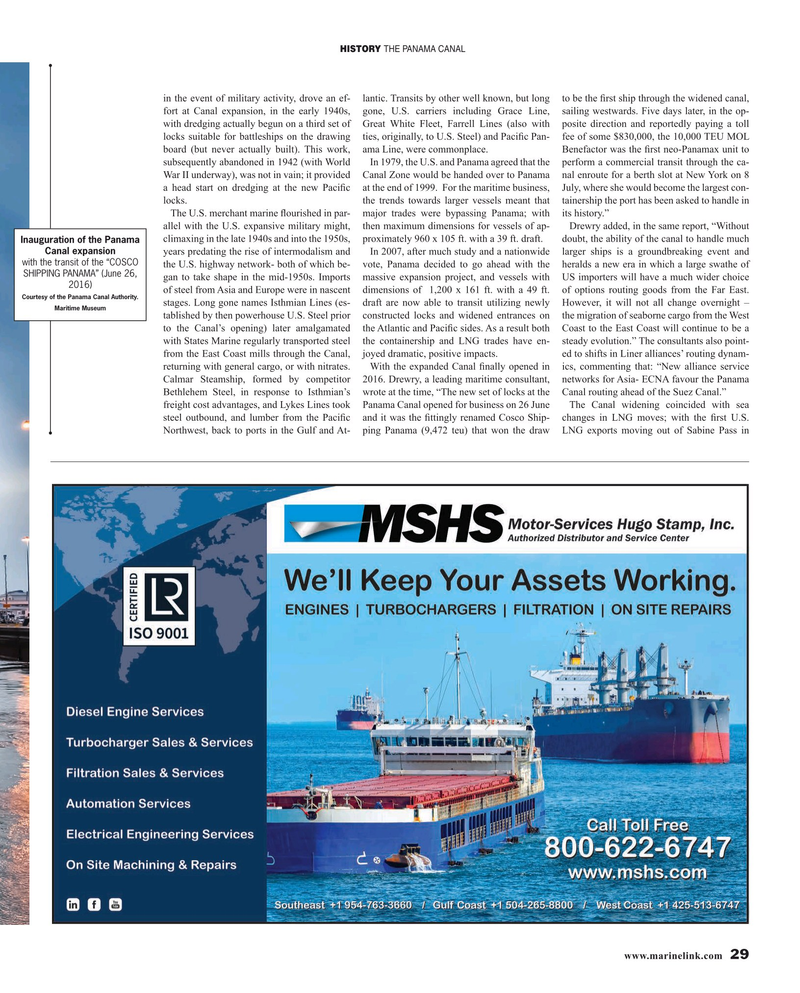
Page 29: of Maritime Reporter Magazine (October 2019)
Marine Design Annual
Read this page in Pdf, Flash or Html5 edition of October 2019 Maritime Reporter Magazine
HISTORY THE PANAMA CANAL in the event of military activity, drove an ef- lantic. Transits by other well known, but long to be the ? rst ship through the widened canal, fort at Canal expansion, in the early 1940s, gone, U.S. carriers including Grace Line, sailing westwards. Five days later, in the op- with dredging actually begun on a third set of Great White Fleet, Farrell Lines (also with posite direction and reportedly paying a toll locks suitable for battleships on the drawing ties, originally, to U.S. Steel) and Paci? c Pan- fee of some $830,000, the 10,000 TEU MOL board (but never actually built). This work, ama Line, were commonplace. Benefactor was the ? rst neo-Panamax unit to subsequently abandoned in 1942 (with World In 1979, the U.S. and Panama agreed that the perform a commercial transit through the ca-
War II underway), was not in vain; it provided Canal Zone would be handed over to Panama nal enroute for a berth slot at New York on 8 a head start on dredging at the new Paci? c at the end of 1999. For the maritime business, July, where she would become the largest con- locks. the trends towards larger vessels meant that tainership the port has been asked to handle in
The U.S. merchant marine ? ourished in par- major trades were bypassing Panama; with its history.” allel with the U.S. expansive military might, then maximum dimensions for vessels of ap- Drewry added, in the same report, “Without climaxing in the late 1940s and into the 1950s, proximately 960 x 105 ft. with a 39 ft. draft. doubt, the ability of the canal to handle much
Inauguration of the Panama
Canal expansion years predating the rise of intermodalism and In 2007, after much study and a nationwide larger ships is a groundbreaking event and with the transit of the “COSCO the U.S. highway network- both of which be- vote, Panama decided to go ahead with the heralds a new era in which a large swathe of
SHIPPING PANAMA” (June 26, gan to take shape in the mid-1950s. Imports massive expansion project, and vessels with US importers will have a much wider choice 2016) of steel from Asia and Europe were in nascent dimensions of 1,200 x 161 ft. with a 49 ft. of options routing goods from the Far East.
Courtesy of the Panama Canal Authority.
stages. Long gone names Isthmian Lines (es- draft are now able to transit utilizing newly However, it will not all change overnight –
Maritime Museum tablished by then powerhouse U.S. Steel prior constructed locks and widened entrances on the migration of seaborne cargo from the West to the Canal’s opening) later amalgamated the Atlantic and Paci? c sides. As a result both Coast to the East Coast will continue to be a with States Marine regularly transported steel the containership and LNG trades have en- steady evolution.” The consultants also point- from the East Coast mills through the Canal, joyed dramatic, positive impacts. ed to shifts in Liner alliances’ routing dynam- returning with general cargo, or with nitrates. With the expanded Canal ? nally opened in ics, commenting that: “New alliance service
Calmar Steamship, formed by competitor 2016. Drewry, a leading maritime consultant, networks for Asia- ECNA favour the Panama
Bethlehem Steel, in response to Isthmian’s wrote at the time, “The new set of locks at the Canal routing ahead of the Suez Canal.” freight cost advantages, and Lykes Lines took Panama Canal opened for business on 26 June The Canal widening coincided with sea steel outbound, and lumber from the Paci? c and it was the ? ttingly renamed Cosco Ship- changes in LNG moves; with the ? rst U.S.
Northwest, back to ports in the Gulf and At- ping Panama (9,472 teu) that won the draw LNG exports moving out of Sabine Pass in www.marinelink.com 29
MR #10 (26-33).indd 29 10/7/2019 11:57:18 AM

 28
28

 30
30
